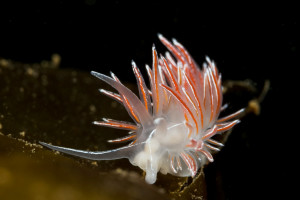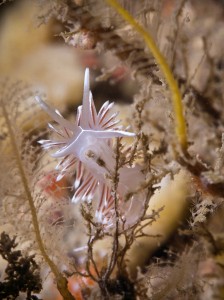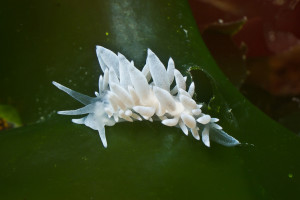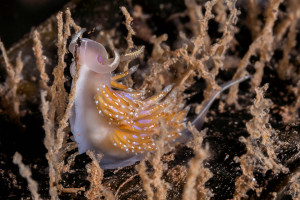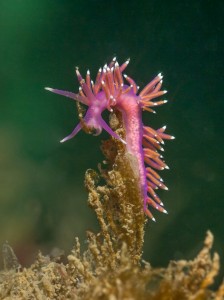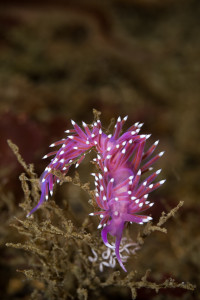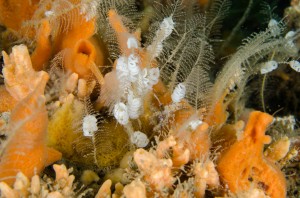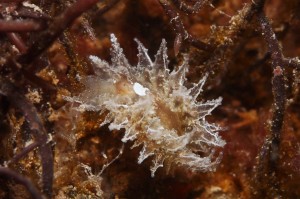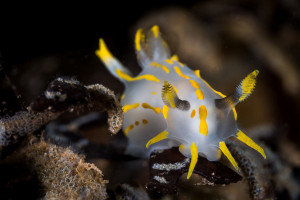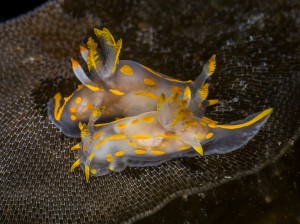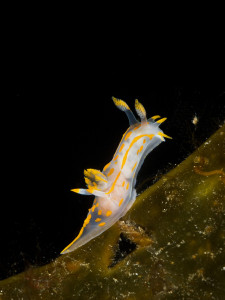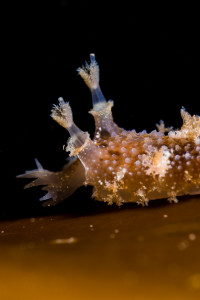Photo / Video News & Reviews
Shooting Nudibranchs
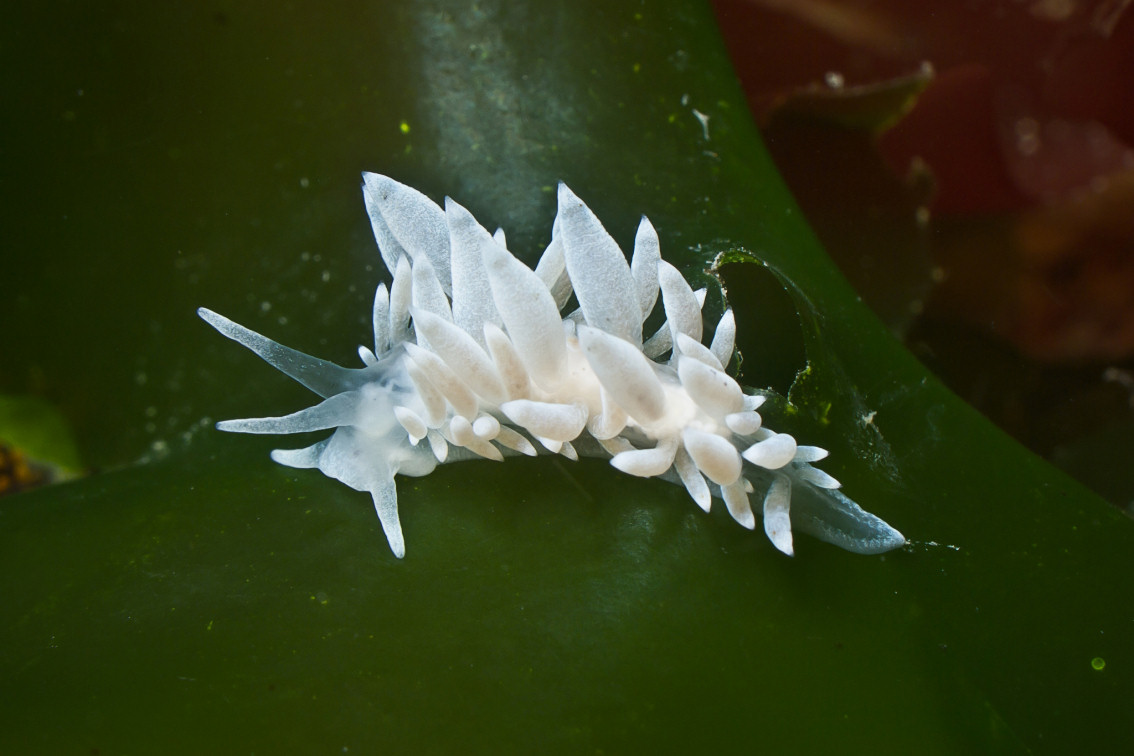
In recent years we have witnessed a rise in the popularity of nudibranchs amongst the scuba diving community, both as a photographic subject and from a natural history point of view. Now that underwater photographers and non photographers alike are seeing these little creatures with a new understanding and renewed interest in their many fascinating forms and behaviours, we are also seeing a rise in tempting photo competitions with dedicated nudibranch categories. In fact very recently I had the privilege to see almost 900 nudibranch photos submitted from photographers in 33 countries to the nudibranch Photo Competition which I was involved in running. And perhaps the most telling sign of this rise in popularity is Alex Mustard’s cover shot of a nudibranch on a UK diving magazine back in January – not a diver, drysuit or bit of shiny tech diving kit anywhere to be seen; just a gorgeous Polycera quadrilineata.
Feeding into, and feeding from, this popularity are numerous macro specific photographic trips and one or two nudibranch safaris being run around the world. A hugely popular trip based in Europe is the Gulen Dive Resort Nudibranch safari in Norway. This isn’t for the feint-hearted as water temperatures can be as low as 2 degrees C, but the clear waters and sheer numbers of slugs (both species and abundance) draws many scientists and underwater photographers to the annual event.
There is a great deal of cross-over between nudibranch photographers and marine scientists who share the same interest. The photographers gain insights into the behaviour, location and abundance of many species; and the scientists get access to many detailed images and greater number of in-water observations that would normally not be possible.
Many photographers develop their own favourite style or technique for shooting in different situations; quite often this is led by the development of new kit, or simply what is considered a fashionable ‘look’ at the time. Taking images of nudibranchs is no different and their many shapes, sizes and forms make them suitable subjects for a variety of techniques.
The most basic approach is to see them as a traditional macro subject and apply tried & tested rules of engagement: macro lens, high shutter speed, small aperture and strobes. Compact camera users need not feel left out, as many models have superb macro capabilities which can be further enhanced using additional close-up ‘wet’ lenses.
Moving beyond this method can open up a whole new creative world to the slug shooter. If you like velvety black backgrounds you might want to try using snoots on your strobes, using ‘inward-lighting’ techniques (where you aim your strobes back in towards the camera & use the very edge of the light cone to light the subject), and cutting your kit down to just a single handle and strobe to facilitate getting very close to your subject.
Going in the opposite direction and keeping some ambient light in your shots will often involve careful control of the strobe as TTL metering sometimes tends to overexpose in this situation so using your strobe in manual can yield much better results.
If you are shooting in temperate waters where ambient light levels are very much lower, keeping an adequate depth-of-field by using your aperture will necessitate using higher ISO settings & lower shutter speeds to let that light into your image. Playing to the strengths of your kit in these situations always pays dividends; if your image stabilization is better than your high ISO performance, then use slower shutter speeds, if not then ISO should be your tool of choice.
Taking a different view of nudibranchs is perhaps where you’ll start to see the greatest opportunities for amazing photos. Observation can be the key to getting interesting behaviour photos and as these critters can move surprisingly quickly, take some practice shots before you carefully approach the subject so you are ready for the action.
Almost every aspect of a nudibranch’s life can be used for behaviour photography; aggregations, mating, egg-lying, feeding, cresting a pebble or frond of weed and sometimes even swimming in midwater give plenty of chances if you know where & when to look.
Close-focus wide-angle is another technique which can be applied to the larger species of nudis. Again, compact camera users are not disadvantaged because many wideangle or fisheye wet lenses have very good close focusing abilities. The most problematic aspect of a CFWA nudibranch shot is getting the light to the subject; the ability to reduce the size of your camera rig and get your strobes as tight to your port as possible is the key. This approach can be used to include a diver in the shot, or perhaps more interestingly place the nudibranch in its habitat – often they feed and live in very colourful and interesting places which can be used to make beautiful images.
As is common practice amongst the majority of underwater photographers, a respect for nudibranchs and their habitat is paramount. This is not just for the benefit of the slugs themselves because if you adopt a sensible and conservation-minded attitude in the water then your images will benefit too.
Many species of nudibranch live on mucky/silty sites so poor finning technique or buoyancy will disturb the sediment and ruin your photographic opportunities.
In every corner of the globe where slugs are found, using just one finger to steady yourself while keeping your body/fins away from the reef/wall/sea-bed should be your standard approach. Just because you can’t see a slug or its food or eggs doesn’t mean they’re not there!
If you shoot for competitions, nudibranchs are a surprisingly versatile subject in their own right and you don’t even need a dedicated category to benefit from their many forms. Lots of competitions have ‘abstract’, ‘behaviour’ and ‘portrait’ categories which all lend themselves to photos of nudis. Applying the techniques discussed previously you’ve also got opportunities in ‘traditional macro’, ‘super macro’ and ‘wide-angle’ categories too.
Sometimes competitions throw up oddly themed sections to test the entrants’ creative abilities. Themes like ‘reflections’, or ‘yellow’ and ‘camouflage’ can all be useful to the nudibranch photographer if you know your species and have the ability to go & find them!
If in-camera manipulation is permitted you can try your hand at a double (or more) exposure that places a close-up shot of a nudibranch onto a cleverly exposed sun-ball or diver silhouette. Tricky to pull off well; but stunning if done properly.
The increasing appeal of nudibranchs is perhaps, in part, down to the fact that there are still new species waiting to be discovered. Even in the most popular diving destinations in the world, every now and then something new pops up and gets the scientists, and photographers, all excited.
In completing the necessary dives for my recent iBook on nudibranchs of south west England, my buddy (and fellow author) Terry Griffiths and I stumbled upon a potential 4 new species whilst diving sites we had be visiting for many years.
It will take some time, and many more dives, to confirm; but the fact illustrates that there’s still so much more out there to be discovered.
News
Meet Insta360 Ace Pro 2: Redefining Action Cameras With Unrivaled 8K Image Quality & Smarter AI

Insta360 is thrilled to announce the latest addition to its Ace series, Insta360 Ace Pro 2. This groundbreaking wide-angle action camera delivers unparalleled image quality, smarter, easier capture powered by AI, upgraded audio, and an improved rugged design made for action at its most extreme.
Co-engineered with Leica, it delivers serious performance upgrades with the industry-first dual AI chip and state-of-the-art imaging courtesy of a new 1/1.3″ 8K sensor and Leica SUMMARIT lens with a 157º field of view. Creators can experience smoother videos with higher frame rates at 8K30fps and 4K60fps Active HDR, PureVideo for excellent low light performance, a bigger 2.5″ flip touchscreen and more.
The action camera utilizes Insta360’s advanced AI technology to offer a smarter experience from shooting to sharing. Innovative functions like the option to pause or cancel a recording, gesture and voice control, Auto Edit, and AI Highlights Assistant completely transform the experience for creators. With no more complex workflows, anyone can experience a simpler way to film and spend more time immersed in the moments they love.

Insta360 Ace Pro 2 significantly improves on its design, offering a more rugged, reliable action camera. Its waterproofing has increased to 39ft (12m), and it offers crystal-clear audio with an integrated Wind Guard and a removable Lens Guard to handle whatever you throw at it, providing full flexibility for action and sports enthusiasts.
“Our goal was to refine and enhance the groundbreaking features of the original Insta360 Ace Pro to deliver an unparalleled experience,” says JK Liu, founder of Insta360. “We are confident these upgrades establish a new industry standard. Not only do they bring significant advances in AI, they empower creators to capture what was always impossible with other action cameras, opening the door to unprecedented creative potential.”
Insta360 Ace Pro 2 is available to order today worldwide via Insta360.com, as well as trusted retailers and select authorized partners.
Unparalleled Image Quality, Day and Night
The Leica SUMMARIT lens immediately sets it apart from competitors with its state-of-the-art image quality. Combined with an upgraded 1/1.3″ 8K sensor offering 13.5 stops of dynamic range, Insta360 Ace Pro 2 delivers simply breathtaking visuals in situations other action cameras simply can’t handle.
Further contributing to its image quality and performance is the industry-leading dual-chip design. Insta360 Ace Pro 2 is the first action camera with a dedicated Pro Imaging Chip that handles image processing and noise reduction, while a separate 5nm AI Chip handles further image processing and overall camera performance, providing a smooth, seamless user experience. The dual chip also enables more shooting modes and higher specifications, such as 8K30fps video, 4K60fps Active HDR (High Dynamic Range), and upgraded PureVideo. Even in fast-moving motion and high-intensity action, creators can enjoy smooth, sharp videos thanks to the higher frame rates or slow it all the way down with crisp 4K120fps slow motion.
A complex, custom-trained AI neural network underpins PureVideo, a specialized shooting mode that drastically reduces noise and enhances details in real time for cleaner, brighter images, even in extreme low light. Whether it’s twilight strolls or evening rides, creators can record what they never could before. For the daytime, upgraded 4K60fps Active HDR brings out all the details in intense highlights and shadows for more vibrant footage. Meanwhile, a wider 157° lens FOV captures more of the surroundings, perfect for vlogging or when the scenery really matters.
Exclusive Leica-engineered color profiles infuse footage with their signature aesthetic, adding a touch of elegance to every shot. Insta360’s devotion to color accuracy is seen elsewhere with Insta360 Ace Pro 2’s ability to retain rich and precise colors, even underwater.
Ready for Action Anytime, Anywhere
The upgraded design proves to be even more rugged, ready for when you ramp up the action. Waterproofing has increased to 39 feet (12 meters) or 197 feet (60 meters) with the Dive Case, and it handles temperatures as low as -4ºF (-20ºC) with ease, perfect for winter sports and extreme climates.
The new, removable Lens Guard provides greater all-around protection, meaning creators can feel confident to push the limits further and capture the impossible, knowing their action cam is up to the challenge.
An all-new Wind Guard keeps wind and noise at a minimum during those peak moments, ready to snap on and off as you need. With refreshed audio algorithms bringing professional-grade clarity to your content, you can immerse your viewers like never before. What’s more, the magnetic mounting system lets you seamlessly switch between accessories. Less time spent unscrewing and screwing your camera and mounts, more time in the moment.
Insta360’s leading FlowState Stabilization technology ensures videos remain incredibly smooth no matter what, while 360º Horizon Lock, now applied automatically in-camera, keeps everything perfectly level. Prioritizing performance and convenience, Insta360 Ace Pro 2 sports a bigger 1800mAh battery and a new Endurance Mode that offers a 50% longer runtime at 4K30fps than Insta360 Ace Pro. Fast charging powers the battery to 80% in 18 minutes or 100% in 47 minutes, so you can get back to the action quicker.
Insta360 has expanded its compatibility with several top third-party sports accessories, allowing action and sports enthusiasts to add a new level of detail. For data-rich videos, overlay real-time stats from third-party sports brands, including Garmin, Apple, COROS, and more. Alternatively, users can add stats from their phone directly in the Insta360 app without any extra gear or use the GPS Preview Remote for easy live preview, remote control, and real-time GPS data. For moto vloggers, pair Insta360 Ace Pro 2 with your motorcycle helmet headset from Sena, Cardo, and more for clear dual-track audio and hands-free control every ride.
Made for those who demand the highest standard of action capture, Insta360 Ace Pro 2 offers the perfect combination of durability and high-quality performance to capture life’s thrills with confidence.

Smarter, Easier Capture & Editing
Insta360 Ace Pro’s flip touchscreen proved an essential and convenient tool for creators and has been further upgraded to 2.5 inches. With a 70% increase in pixel density, a 6% increase in brightness and a 100% increase in flip durability, it allows for perfect framing and easier preview for vlogging, selfies, and difficult angles, all while remaining visible under bright sunlight. Instead of guessing if your shot looks perfect, you can shoot with confidence, knowing it is.
Internally, Insta360 Ace Pro 2 offers innovative solutions to problems that have hindered action enthusiasts for years:
- 4K Clarity Zoom – Want a close-up but the image quality becomes too grainy? Zoom in and out 2x without losing quality.
- Pre-Recording – Never miss a moment with up to 120 seconds of footage saved before you even hit record.
- Gesture & Voice Control – Use quick hand signals or verbal commands to control the camera, such as start/stop recording or take a photo, ideal if it’s mounted out of reach.
- Pause/Resume Recording – Got time between shots? Hit pause and continue recording when you need to keep everything in one continuous file for easier file management and editing.
- Timecode – Seamlessly synchronizes multiple cameras for an efficient editing workflow.
Insta360’s revolutionary AI features demonstrate a commitment to making shooting and editing as accessible as possible. Anyone, regardless of their skill level, will be amazed at what they can create. For those who aren’t confident editing, AI Highlights Assistant automatically finds the best moments from a video and delivers the highlights for review, all in-camera. Creators can merge every thrilling moment into one incredible recap or choose the ones their favorites and delete any unwanted clips to save storage.
The Assistant also helps craft your next reel from your adventures and pushes it directly to your smartphone via the Insta360 app. Look back on all your Memories and share those unforgettable moments in seconds.
Acting as a full editing suite in your pocket, the Insta360 mobile app fully embraces the game-changing possibilities of AI with advanced Auto Editing, one-tap templates and creative Shot Lab effects. Instead of spending hours learning complex tools and editing workflows, AI does it all for you, bringing your clips to life with dynamic cuts and transitions. Creators can even achieve the infamous Invisible Selfie Stick effect with the AI Selfie Stick Eraser in the app for third-person views. Looking for a real twist? AI Warp uses preset or custom keywords to bring your wildest ideas to life.
Available Now
Insta360 Ace Pro 2 is available to purchase today worldwide via Insta360.com and select retailers. The Standard Bundle retails for US$399.99 and includes a Wind Guard, Battery, Standard Mount, Mic Cap, and USB-C Cable. The dual battery bundle includes the same accessories and two batteries for US$419.99.
News
Introducing the Nauticam Super Macro Converter 3

The SMC-3
Nauticam is proud to introduce the SMC-3, the latest evolution in our line of water contact optics! Designed as a renewed version of the acclaimed SMC-1, the SMC-3 boasts a lightweight build—now only one-third the weight of its predecessor—without compromising on optical performance.
SMC-3 Specifications
| Dimensions | OD 70mm x H 32mm |
| Weight in Air | 307g |
| Weight in Water | 215g |
| Max Magnification (*1) | 2.4x (lens dependent) |
| Working Distance (*1) | 51-103mm |
| Lens Construction | 3 elements in 2 groups |
| Lens Coatings | Anti-reflection Coating |
| Mount Thread Diameter | M67 |
| Depth Rating |
100mm |

Tested with Nikon AF-S VR Micro-Nikkor 105mm f/2.8G IF-ED
Key Features
- Ultra-Lightweight Design: Weighing in at just one-third of the SMC-1, the SMC-3 offers unparalleled portability for on-the-go use.
- Superior Optical Performance: Enjoy the same exceptional clarity and precision you’ve come to expect from the SMC series.
- Increased Working Distance: The redesigned lens allows for a greater working distance, meaning it’s easier to use and provides enhanced versatility.
- Premium Materials: Crafted with advanced materials to enhance durability while minimizing weight.
- Cost-Effective: Slightly more affordable than the discontinued SMC-1, the SMC-3 delivers exceptional value.
Uncompromised Optical Quality
The Super Macro Converter 3 is constructed from lenses that are precision crafted of specially formulated low dispersion optical grade glass, ground to the most demanding standards. These exceptional measures, enhanced by broadband anti-refective coatings effectively reduce common optical issues such as chromatic aberrations, coma, spherical aberration, and field deformation associated with underwater macro photography using traditional magnifying lenses. These optics are assembled in a rugged hard anodized aluminum housing, and nitrogen purged during assembly to eliminate fogging.
Stunning Magnification
When combined with a full frame camera and a 100mm or 105mm macro lens, the device converts the optical system to provide a maximum of 2.4X magnification factor. In other words, a subject area of 15.6mm X 10.4mm will fill the whole frame of a 36mm X 24mm sensor.
Improved Sharpness and Contrast
As the Super Macro Converter 3 is optimized explicitly for using together with a macro lens underwater, images captured exhibit exceptional sharpness compared with conventional magnification lenses. Thanks to the broadband multi-layer anti-reflection coating on each surface of the lenses, images also exhibit higher contrast.
Superb Light Transmission
All the lens elements installed inside the SMC are optically optimized to appropriate diameters so as to provide maximum light transmission. The SMC doesn’t suffer from vignette issues under even the most extreme conditions. The broad band multi-layer anti-reflection coating on all surfaces also greatly improves light transmission.
Optimized for Autofocus
By utilizing a specially developed algorithm in the optimization process, the SMC renders superior image quality over the full focusing range of the camera lens (which becomes ~50 to ~100 mm in front of the SMC). Also benefitting from the high brightness and contrast of the image, the autofocus system of the camera usually works acceptably well within this range.

Ample Working Distance
Even at the maximum 2.3X magnification, there is still more than 50mm of working distance between the front element and the subject with 100/105mm macro lenses. This working distance is crucial when capturing behavior with skittish subjects.
Resolution
High resolution was a primary design goal of the SMC project. This has been achieved using computer aided optimization and high grade optical glasses with unique refractive and dispersion properties. Images taken with this new system exhibit very high resolution and quality. Results have exceeded expectations, and these images rival the quality of the macro lens in air.
Smooth Bokeh
The Converter retains the optical properties of the macro lens for the whole system underwater, resulting in a blurred (out of focus) background that has a pleasing smoothness and creamy look, without the normal purple and green fringing.
Avoiding Diffraction
Due to the overall superior optical performance of the SMC-3 it is possible to shoot larger apertures with excellent image quality. This avoids reaching the diffraction limit of high resolution sensors, and allows selective focus effects with narrow depth of field in super macro images.
For more information about the Nauticam Super Macro Converter 3, which ships in November, click here.
-

 News1 month ago
News1 month agoIconic SS United States to become the World’s Largest Artificial Reef
-

 Blogs3 months ago
Blogs3 months agoNovoScuba’s Game-Changing Approach for Dive Store Owners: WE PAY YOU!
-

 News2 months ago
News2 months agoBook Review – 52 Assignments: Underwater Photography
-

 Gear News2 months ago
Gear News2 months agoDYNAMICNORD – New German diving brand enters the British market
-

 News2 months ago
News2 months agoExploring Cenote El Pit: A Diver’s Dream
-

 Gear News2 months ago
Gear News2 months agoTry BARE drysuits (and maybe even win one!) this Friday with Sea & Sea at North West Dive Fest
-

 News3 months ago
News3 months agoComing Soon – 52 Assignments
-

 News3 months ago
News3 months agoSave £200 per person per week at Pole Pole Lodge with Dive Worldwide


